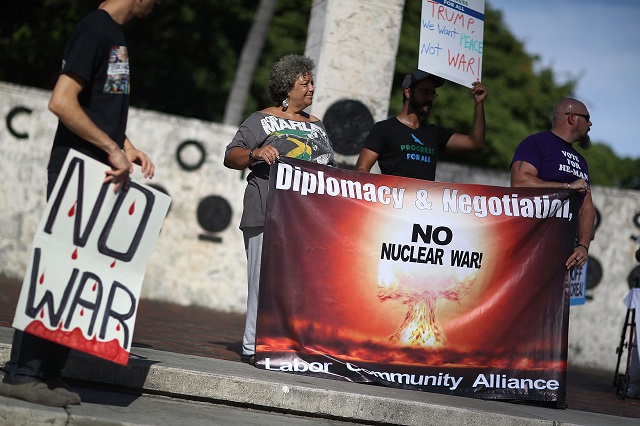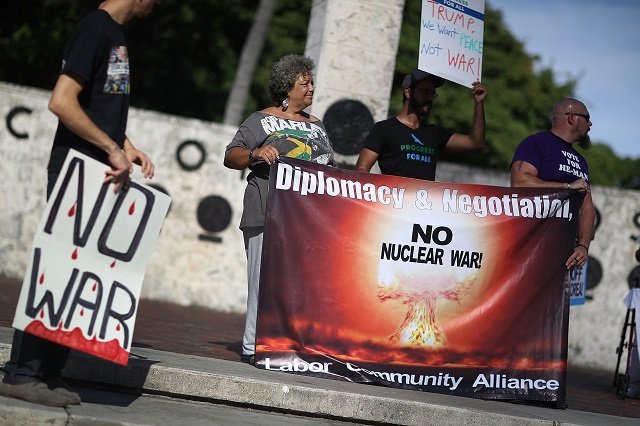
 Protesters gather to ask President Donald Trump to stop his drive to war against North Korea on August 14, 2017, in Miami, Florida. (Photo: Joe Raedle / Getty Images)
Protesters gather to ask President Donald Trump to stop his drive to war against North Korea on August 14, 2017, in Miami, Florida. (Photo: Joe Raedle / Getty Images)
Ever since the Trump administration began a few months ago to threaten a first strike against North Korea over its continued missile tests, the question of whether it is seriously ready to wage war has loomed over other crises in US foreign policy.
The news media have avoided any serious effort to answer that question, for an obvious reason: The administration has an overriding interest in convincing the North Korean regime of Kim Jong-un that Trump would indeed order a first strike if the regime continues to test nuclear weapons and an intercontinental ballistic missile (ICBM). Therefore, most media have shied away from digging too deeply into the distinction between an actual policy of a first strike and a political ruse intended to put pressure on Pyongyang.
The use of military threat for “diplomatic coercion” is such a basic tool of US policy in dealing with weaker adversaries that it is almost taken for granted in Washington. Even diplomats who have been deeply involved in negotiating with North Korea are supportive of using that threat as part of a broader diplomatic strategy. Robert Gallucci, the State Department official who negotiated the “Agreed Framework” with North Korean officials in 1994, noted in an email to Truthout, “We do want the North to understand that their actions could lead the US to a preventive strike — wise or not.”
The linkage between the Trump administration’s threat of a “military option” and US diplomatic pressure on North Korea was clear from its first suggestion that it might carry out a first strike. That suggestion came on April 13, immediately upon the completion of the administration’s policy review on North Korea, when NBC News reported that “multiple senior intelligence officials” had said that the administration was “prepared to launch a preemptive strike” if officials “became convinced that North Korea is about to follow through with a nuclear weapon test.” A story in the Washington Post published the following day offered a slightly different version: The administration was “prepared to respond to another North Korean nuclear test” and had “a range of options at its disposal” but would not “telegraph its response in advance.”
However, an unnamed military official told the Associated Press that same day that the policy that had been approved by the National Security Council did not envision the use of force in response to a nuclear or missile test, thus revealing that the leaks involving the threat of a preemptive or retaliatory attack over North Korean testing were part of a clumsy effort at “coercive diplomacy.”
Further buttressing that interpretation are revelations that top Pentagon officials are dubious that a first strike against North Korean missile and nuclear sites could be completely successful. In response to a letter from Congressman Ted Lieu (D-California), Rear Admiral Michael J. Dumont, the vice director of Joint Staff, which works under the authority of the Joint Chiefs of Staff, made a remarkable revelation: The only way to “locate and destroy — with complete certainty — all components of North Korea’s nuclear programs” is “through ground invasion.”
An unidentified senior Pentagon official went even further, telling Harry J. Kazianis, director of defense studies at the Center for the National Interest, “We don’t know where all the nuclear weapons and missiles are. Period.” Other Pentagon officials confirmed the same point to Kazianis. Those admissions, which undercut the effort to convince North Korea that a US first strike is not only feasible but is possible if it continues on its present course, make it clear that the top civilian and military leaders at the Pentagon do not support a first strike policy.
The main reason for the Pentagon’s open reluctance to embrace such an option, however, is that military leaders are well aware that North Korea could respond to a US first strike on its missile and nuclear targets with a devastating artillery and rocket attack on the, South Korean capital, Seoul. According to a Stratfor report, North Korean artillery batteries and 300 mm rocket launchers, burrowed into the side of granite mountains just north of the demilitarized zone, could deliver “roughly the same amount of ordinance dropped by 11 B-52 bombers.” And although the US and South Korean air forces would begin immediately to counterattack those batteries and launchers, it would be too late to prevent extremely high civilian casualties.
Despite these clear indications of military opposition to maintaining a US first-strike threat, some Trump administration officials have sought to keep that threat alive. Van Jackson, who was country director for Korea in the Office of the Secretary of Defense from 2009 to 2014 and now teaches at Victoria University in Wellington, New Zealand told Truthout that key figures in the Trump administration believe that the United States must do whatever is necessary to stop the North Korean development of a missile capable of reaching the United States with a nuclear weapon. “My sources are telling me that everybody in the administration except Tillerson and Mattis believes that, if North Korea has the capability, they will use it,” Jackson said in an interview.
The consensus among North Korea specialists in the Obama administration had been that North Korea was pursuing nuclear weapons as a deterrent to ensure regime survival, according to Jackson. But now, he says, National Security Adviser H. R. McMaster and Matt Pottinger, the national security council director for Asia, have adopted a radically different view. “They say North Korea is not deterrable, so its development of an ICBM must not be allowed,” Jackson said.
Jackson agrees that Secretary of Defense James Mattis opposes the option of a US first strike against North Korea, but he fears that McMaster and Pottinger have won Trump over to their argument. That would explain why the Trump administration has adopted the adamant position that it will not negotiate with North Korea except on the premise of complete denuclearization. Most of the national security elite regard such a demand as impossible to attain, especially since the Pentagon doesn’t even know where the weapons are.
Even as he was advancing the idea that North Korea wouldn’t be deterred once it could reach the United States, however, McMaster was reportedly arguing that the regime can now be deterred from responding to a very precise US attack on its missile sites. Former State Department official Mark Fitzpatrick, now head of the Washington office of the London-based International Institute for Strategic Studies observed on November 8, that the belligerent line taken by McMaster and the White House was based on “the assumption that North Korea would not respond forcefully” to a US attack on its missile test and launching facilities, “because it would know it would lose everything in the war that would follow.” Fitzpatrick noted, however, that a defector from North Korea’s embassy in London, Thae Yong-ho, had warned that the North Korean response to any attack, “no matter how small,” would be “fierce.”
The Trump administration could seek to increase the pressure on North Korea still further by making one or more moves preparing for — but short of — war. For example, it could bring more US ground troops into South Korea or Japan. However, the North Korean regime might well interpret that move as a signal that the US intends to attack and invade the North, since that would seem to be precisely the purpose of moving reinforcements into the theater. In fact, according to Jackson, the North Koreans told US diplomats during the 1994 crisis that they had studied carefully the US large-scale troop movements in preparation for the first Gulf War in 1990-91, and warned that they would respond to a move like that one in their region by launching their own preemptive attack.
It isn’t yet possible to know definitely whether the Trump administration intends to strike first against North Korea. The official threats of such a strike can be discounted as obviously related to an elaborate — if somewhat crude — psychological warfare campaign. But more twists and turns in US policy can be expected in the coming months, and the desperate desire to coerce Pyongyang may also have given rise to wishful thinking on the part of McMaster and, more dangerously, Trump himself, about deterring that regime’s response to a US first strike. That in turn could still pose a grave threat of yet another unnecessary and terrible war.